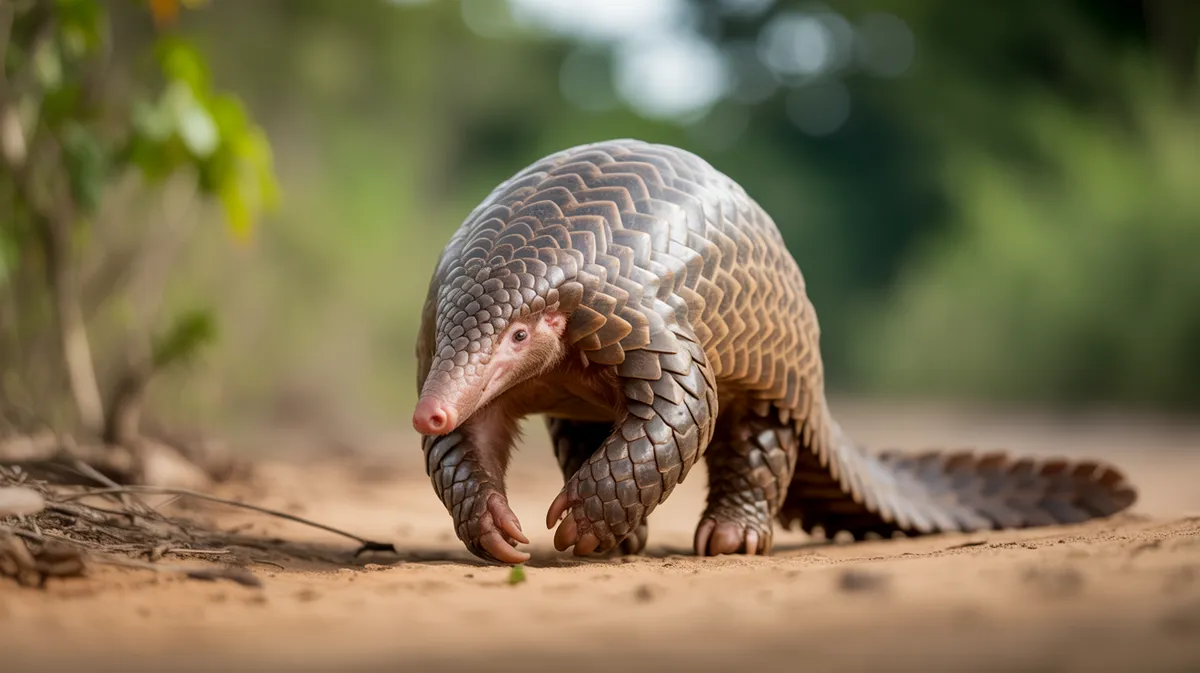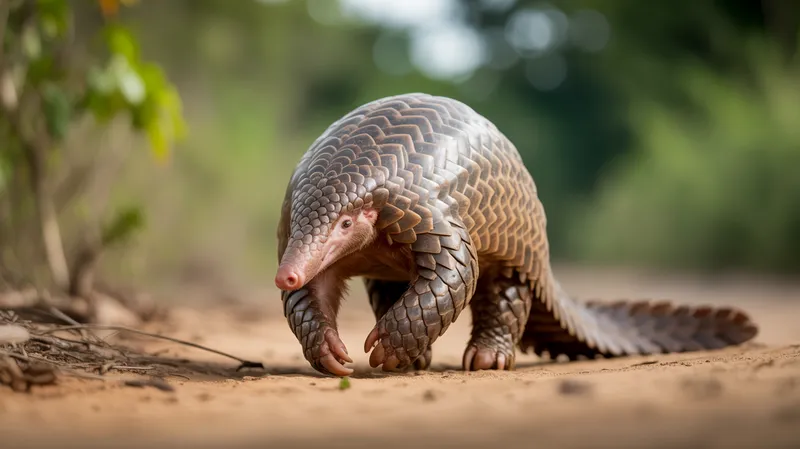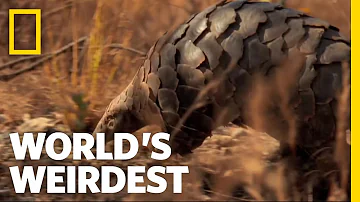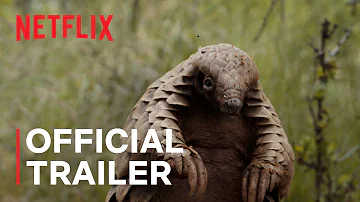
Pangolin
Manis spp.

Meet the Pangolin
Pangolins are unique, scale-covered mammals known for their shy nature and impressive defense mechanisms. Found across parts of Asia and Africa, these nocturnal creatures are the only mammals wholly covered in protective keratin scales, which they use to shield themselves from predators by curling into a tight ball. Pangolins are specialized insectivores, feeding primarily on ants and termites, which they extract from nests using their long, sticky tongues. Despite their ecological importance, pangolins are critically threatened due to illegal wildlife trade and habitat loss. Conservation efforts are ongoing to protect these fascinating animals from extinction.
Classification
Mammal
Habitat
Tropical and subtropical forests, savannas, and grasslands
Diet
Insectivore
Lifespan
10-20 years
Conservation
Critically Endangered
Weight
1.6–33 kg (3.5–73 lbs) depending on species
📖Fascinating Facts
Unique Armor
A pangolin's body is covered with tough, overlapping scales made of keratin—the same protein found in human hair and nails.
Extremely Long Tongue
Pangolins have exceptionally long, sticky tongues—sometimes exceeding the length of their body—which they use to capture ants and termites deep within nests.
Defense Curl
When threatened, pangolins curl into a tight ball, using their tough scales as armor to protect themselves from predators.
📋Detailed Description
Pangolins (order Pholidota) are medium-sized, nocturnal mammals distinguished by their overlapping, keratinous scales, which constitute about 20% of their body weight and provide formidable protection against predators. Adult pangolins range in length from 30 to 100 cm, with tails that may be as long as their bodies, especially in arboreal species. Their bodies are elongated and streamlined, with small, conical heads, reduced external ears, and poor eyesight, compensated by an acute sense of smell. Pangolins possess powerful, curved claws on their forelimbs, which they use to break into termite mounds and ant nests. Their tongues are exceptionally long—sometimes exceeding the length of their head and body combined—sticky, and anchored deep within the thorax, allowing efficient extraction of insects. Most pangolins are solitary, occupying large home ranges, and are primarily terrestrial, though some Asian species are adept climbers. They are highly secretive, spending daylight hours in burrows or tree hollows and emerging at night to forage. Pangolins have a low metabolic rate and lack teeth, relying on a muscular, keratinized stomach to grind their prey. Their reproductive rates are low, with most species producing a single offspring per litter, and maternal care is pronounced, with young riding on the mother's tail or back. These unique mammals are evolutionarily distinct, with no close living relatives, and play a crucial ecological role in controlling insect populations.
💡 Did you know?
Pangolins are the most trafficked mammals in the world, with their scales and meat highly sought after in illegal wildlife trade.
🔬Research & Sources
Wikipedia Summary
Pangolins, sometimes known as scaly anteaters, are mammals of the order Pholidota. The one extant family, the Manidae, has three genera: Manis, Phataginus, and Smutsia. Manis comprises four species found in Asia, while Phataginus and Smutsia include two species each, all found in sub-Saharan Africa. These species range in size from 30 to 100 cm. Several extinct pangolin species are also known. In September 2023, nine species were reported.
Last Modified: 6/11/2025
🎭Behavior & Social Structure
Pangolins are predominantly nocturnal and solitary, with individuals occupying overlapping but largely exclusive territories. They are highly fossorial or arboreal depending on species, using their strong forelimbs to dig extensive burrows or climb trees. Foraging is primarily conducted at night, guided by olfaction to locate ant and termite colonies. Pangolins use their claws to break open nests and rapidly flick their long, sticky tongues in and out to capture prey, consuming up to 200,000 insects in a single night. They exhibit defensive behaviors such as rolling into a tight ball, tucking their head under the tail, and emitting foul-smelling secretions from anal glands when threatened. Social interactions are minimal outside of mating and maternal care, and individuals communicate through scent marking and occasional vocalizations such as hissing or puffing. Daily routines involve alternating periods of rest in secure shelters and active foraging, with activity peaks shortly after dusk and before dawn.
👶Reproduction & Life Cycle
Pangolin reproduction is characterized by low fecundity. Mating typically occurs during specific breeding seasons, which vary by region but often coincide with the onset of the rainy season. Courtship involves scent marking and following by the male. After mating, gestation lasts between 65 and 140 days depending on species. Most pangolins give birth to a single, well-developed offspring, though twins are rare. The neonate is born with soft, white scales that harden within days. The mother nurses the young in a burrow or tree hollow, and the juvenile rides on her back or tail during foraging trips. Weaning occurs at 2–3 months, but the young may remain with the mother for up to six months. Sexual maturity is reached at 2–3 years. Parental care is exclusively maternal, and males do not participate in rearing.
🛡️Adaptations & Survival
Pangolins exhibit a suite of specialized adaptations for myrmecophagy (ant and termite eating). Their robust, recurved claws enable them to break into hard insect nests, while their elongated, highly protrusible tongues—supported by an extended xiphisternum—allow deep probing into tunnels. The absence of teeth is compensated by a gizzard-like stomach lined with keratinous spines that grinds prey, often aided by ingested sand or small stones. Their scales, composed of tough keratin, provide nearly impenetrable armor against predators such as big cats. Pangolins can close their ears and nostrils to keep out insects and debris while feeding. Behavioral adaptations include nocturnality to avoid diurnal predators and heat stress, and secretive, solitary habits to minimize detection. Arboreal species possess prehensile tails for climbing, while terrestrial species have powerful limbs for digging.
🎨Cultural Significance
Pangolins hold diverse roles in human culture. In parts of Africa and Asia, their scales are used in traditional medicine, amulets, and rituals, believed to cure ailments or bring good fortune, despite lack of scientific evidence. Their meat is consumed as a status symbol in some regions. In folklore, pangolins are sometimes seen as symbols of tenacity and protection. Increasingly, they have become icons for wildlife conservation, with international campaigns highlighting their plight and ecological importance.
🔬Recent Research & Discoveries
Recent research has focused on pangolin genomics, revealing unique immune system adaptations and insights into keratin scale formation. Studies have clarified phylogenetic relationships, confirming pangolins as a distinct lineage with no close relatives among living mammals. Conservation biology research has improved understanding of pangolin ecology, home range sizes, and reproductive biology, informing anti-poaching strategies. Notably, pangolins were investigated as potential intermediate hosts for coronaviruses, but current evidence does not support a direct link to SARS-CoV-2. Ongoing studies aim to develop effective captive husbandry protocols and to map trafficking networks using genetic forensics.
🎥Wildlife Videos

Pangolins: The Most Trafficked Mammal You've Never Heard Of | National Geographic
What are pangolins? If you've never heard of the pangolin, you're not alone. This shy creature, as big as your cat or dog, is the ...
National Geographic

Eye of the Pangolin. Pangolin Documentary in HD.
What is a Pangolin? Where do Pangolins live? In this beautifully filmed PANGOLIN DOCUMENTARY, we follow two intrepid ...
Pangolin.Africa

Pangolin | World's Weirdest
#NatGeoWILD #WorldsWeirdest #Pangolin About World's Weirdest: A buffalo with three eyes, an exterminator who eats his day's ...
Nat Geo Animals

Wild Vietnam: Pangolins, Primates, and the Land of Mountain Forests (Full Episode) | Nat Geo Wild
Travel to Vietnam's mountains to visit crocodile lizards, endangered pangolins, and rare primates: the golden-headed langurs of ...
Nat Geo Animals

Pangolin: Kulu’s Journey | Official Trailer | Netflix
A man finds new purpose when he helps rescue a baby pangolin, one of the most trafficked animals in the world, in a sting ...
Netflix

Pangolins and Aardvarks Search for Termites | 4K UHD | Seven Worlds One Planet | BBC Earth
The Kalahri Desert has plenty of food, but only if you can find it. Using their amazing sense of smell and digging skills, both ...
BBC Earth
🌍Habitat Information
The Pangolin typically inhabits Tropical and subtropical forests, savannas, and grasslands environments. Pangolins have adapted to their environments with specialized features and behaviors.
Primary Habitat:
Tropical and subtropical forests, savannas, and grasslands
More detailed habitat information will be available soon.
🛡️Conservation Status
The Pangolin is currently classified as Critically Endangered. Conservation efforts are crucial for preserving this species for future generations.
Common Threats:
- 🏠Habitat loss and fragmentation
- 🌡️Climate change impacts
- 🎯Hunting and poaching
- 🏭Human-wildlife conflict
⚠️Threats & Conservation Challenges
Pangolins are among the most trafficked mammals globally, facing severe threats from illegal hunting for their scales, which are erroneously believed to have medicinal properties, and for their meat, considered a delicacy in some cultures. Habitat loss due to deforestation and agricultural expansion further exacerbates population declines. All eight recognized species are listed as threatened, with several classified as Critically Endangered by the IUCN. Population trends are declining, with some local extinctions reported. Conservation challenges include limited ecological data, difficulties in captive breeding due to specialized diets and stress sensitivity, and persistent demand in black markets. Enforcement of international trade bans (CITES Appendix I) is ongoing but hampered by insufficient resources and corruption.
🔬Scientific Classification
Scientific Name
Manis spp.
Classification Hierarchy
🔍 About Taxonomic Classification
Taxonomic classification is a hierarchical system used by scientists to classify and organize living organisms based on shared characteristics and evolutionary relationships.
The system moves from broad categories (Kingdom) to increasingly specific ones, with each animal's scientific name typically consisting of its Genus and species.
📝Community Notes
Share your observations and insights about the Pangolin with our community of wildlife enthusiasts.
Join Our Community
Sign in to share your observations and connect with fellow wildlife enthusiasts.
Sign In to ContributeNo community notes yet
Be the first to share your observations about the Pangolin!
Explore Pangolin
Select a tab above to learn more about this amazing animal.
📸Photo Gallery
No photos available for this animal yet.
🌟Discover More Wildlife
Continue your journey of discovery with more fascinating animals from our database
